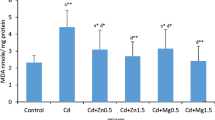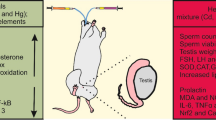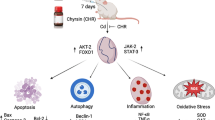Abstract
Cadmium (Cd) is a highly toxic element, which may cause toxicity to most organs in the body. Zinc (Zn) and magnesium (Mg) are essential minerals with probable benefits on Cd harmful effects. Finding an efficient and non-pathological treatment against Cd toxicity seems promising. Fifty adult rats were divided into ten experimental groups of five rats each. The Cd group was treated with 1 mg Cd/kg and the control group received 0.5 cm3 normal saline. The other eight groups received Zn (0.5 and 1.5 mg/kg) and Mg (0.5 and 1.5 mg/kg) either alone or in combination with 1 mg Cd/kg through IP injection for 3 weeks. Testis malondialdehyde (MDA), sperm parameters, and testis histopathology were investigated. Cd reduced sperm parameters and increased testis MDA. Moreover, Cd exposure caused a significant histological damage in testis of male rats. However, Zn or Mg treatment prevented and reversed Cd toxic alterations in testis. These findings suggest that co-administration of Zn or Mg could improve cadmium testicular toxicity in male Wistar rats.






Similar content being viewed by others
References
Zegers-Hochschild F, Adamson GD, de Mouzon J, Ishihara O, Mansour R, Nygren K, Sullivan E, Vanderpoel S (2009) International Committee for Monitoring Assisted Reproductive Technology (ICMART) and the World Health Organization (WHO) revised glossary of ART terminology, 2009. Fertil Steril 92(5):1520–1524. https://doi.org/10.1016/j.fertnstert.2009.09.009
Feng HL (2003) Molecular biology of male infertility. Arch Androl 49:19–27
Sharma R, Biedenharn KR, Fedor JM, Agarwal A (2013) Lifestyle factors and reproductive health: taking control of your fertility. Reprod Biol Endocrinol 11(1):66. https://doi.org/10.1186/1477-7827-11-66
Wong EW, Cheng CY (2011) Impacts of environmental toxicants on male reproductive dysfunction. Trends Pharmacol Sci 32(5):290–299. https://doi.org/10.1016/j.tips.2011.01.001
Meeker JD, Rossano MG, Protas B, Diamond MP, Puscheck E, Daly D, Paneth N, Wirth JJ (2008) Cadmium, lead, and other metals in relation to semen quality: human evidence for molybdenum as a male reproductive toxicant. Environ Health Perspect 116(11):1473–1479. https://doi.org/10.1289/ehp.11490
Siu ER, Mruk DD, Porto CS, Cheng CY (2009) Cadmium-induced testicular injury. Toxicol Appl Pharmacol 238(3):240–249. https://doi.org/10.1016/j.taap.2009.01.028
Laskey JW, Rehnberg GL, Laws SC, Hein JF (1984) Reproductive effects of low acute doses of cadmium chloride in adult male rats. Toxicol Appl Pharmacol 73(2):250–255. https://doi.org/10.1016/0041-008X(84)90330-2
Amara S, Abdelmelek H, Garrel C, Guiraud P, Douki T, Ravanat JL et al (2008) Preventive effect of zinc against cadmium-induced oxidative stress in the rat testis. J Reprod Dev 54(2):129–134. https://doi.org/10.1262/jrd.18110
Benoff S, Hauser R, Marmar JL, Hurley IR, Napolitano B, Centola GM (2009) Cadmium concentrations in blood and seminal plasma: correlations with sperm number and motility in three male populations (infertility patients, artificial insemination donors, and unselected volunteers). Mol Med 15(7-8):248–262. https://doi.org/10.2119/molmed.2008.00104
He L, Wang B, Hay EB, Nebert DW (2009) Discovery of ZIP transporters that participate in cadmium damage to testis and kidney. Toxicol Appl Pharmacol 238(3):250–257. https://doi.org/10.1016/j.taap.2009.02.017
Al-Azemi M, Omu FE, Kehinde EO, Anim JT, Oriowo MA, Omu AE (2010) Lithium protects against toxic effects of cadmium in the rat testes. J Assist Reprod Genet 27(8):469–476. https://doi.org/10.1007/s10815-010-9426-3
El-Demerdash FM, Yousef MI, Kedwany FS, Baghdadi HH (2004) Cadmium-induced changes in lipid peroxidation, blood hematology, biochemical parameters and semen quality of male rats: protective role of vitamin E and beta-carotene. Food Chem Toxicol 42(10):1563–1571. https://doi.org/10.1016/j.fct.2004.05.001
Wong WY, Flik G, Groenen PM, Swinkels DW, Thomas CM, Copius-Peereboom JH et al (2001) The impact of calcium, magnesium, zinc, and copper in blood and seminal plasma on semen parameters in men. Reprod Toxicol 15(2):131–136. https://doi.org/10.1016/S0890-6238(01)00113-7
Wu SH, Oldfield JE, Whanger PD, Weswig PH (1973) Effect of selenium, vitamin E, and antioxidants on testicular function in rats. Biol Reprod 8:625–629
Matovic V, Bulat ZP, Djukic-cosic D, Soldatovic D (2010) Zinc, copper, or magnesium supplementation against cadmium toxicity. Nova Science Publishers, UK
Chasapis CT, Loutsidou AC, Spiliopoulou CA, Stefanidou ME (2012) Zinc and human health: an update. Arch Toxicol 86(4):521–534. https://doi.org/10.1007/s00204-011-0775-1
Zhao J, Dong X, Hu X, Long Z, Wang L, Liu Q, Sun B, Wang Q, Wu Q, Li L (2016) Zinc levels in seminal plasma and their correlation with male infertility: a systematic review and meta-analysis. Sci Rep 6(1):22386. https://doi.org/10.1038/srep22386
Bonda E, Wlostowski T, Krasowska A (2004) Testicular toxicity induced by dietary cadmium is associated with decreased testicular zinc and increased hepatic and renal metallothionein and zinc in the bank vole (Clethrionomys glareolus). Biometals 17(6):615–624. https://doi.org/10.1007/s10534-004-1226-8
Rafique M, Pervez S, Tahir F (2010) Protective effect of zinc over lead toxicity on testes. J Coll Physicians Surg Pak 20:377–381
Ahmadi S, Bashiri R, Ghadiri-Anari A, Nadjarzadeh A (2016) Antioxidant supplements and semen parameters: an evidence based review. Int J Reprod Biomed 14:729–736
Theophanides T, Anastssopoulou J (1997) Magnesium: current status and new developments. Springer, Netherlands. https://doi.org/10.1007/978-94-009-0057-8
Jacobs RM, Jones AO, Fox MR, Lener J (1983) Effects of dietary zinc, manganese, and copper on tissue accumulation of cadmium by Japanese quail. Proc Soc Exp Biol Med 172:34–38
Noel L, Huynh-Delerme C, Guerin T, Huet H, Fremy JM, Kolf-Clauw M (2006) Cadmium accumulation and interactions with zinc, copper, and manganese, analysed by ICP-MS in a long-term Caco-2 TC7 cell model. Biometals 19(5):473–481. https://doi.org/10.1007/s10534-005-5147-y
Matovic V, Plamenac Bulat Z, Djukic-Cosic D, Soldatovic D (2010) Antagonism between cadmium and magnesium: a possible role of magnesium in therapy of cadmium intoxication. Magnes Res 23(1):19–26. https://doi.org/10.1684/mrh.2010.0196
National Research Council (US) (2011) Committee for the Update of the Guide for the Care and Use of Laboratory Animals, 8th edn, Washington (DC), National Academies Press (US)
Jacquillet G, Barbier O, Cougnon M, Tauc M, Namorado MC, Martin D, Reyes JL, Poujeol P (2006) Zinc protects renal function during cadmium intoxication in the rat. Am J Physiol Renal Physiol 290(1):F127–F137. https://doi.org/10.1152/ajprenal.00366.2004
Ben KL, Hamilton MS, Alexander NJ (1988) Vasectomy-induced autoimmunity: monoclonal antibodies affect sperm function and in vitro fertilization. J Reprod Immunol 13(1):73–84. https://doi.org/10.1016/0165-0378(88)90050-2
Golshan Iranpour F, Rezazadeh Valojerdi M (2013) The epididymal sperm viability, motility and DNA integrity in dead mice maintained at 4-6oC. Iran J Reprod Med 11(3):195–200
Mdhluli MC, van der Horst G (2002) The effect of oleanolic acid on sperm motion characteristics and fertility of male Wistar rats. Lab Anim 36(4):432–437. https://doi.org/10.1258/002367702320389107
WHO Organization (2010). Laboratory Manual for the Examination of Human Semen and Sperm-Cervical Mucus Intraction New York: Cambridge University Press
Esterbauer H, Cheeseman KH (1990) Determination of aldehydic lipid peroxidation products: malonaldehyde and 4-hydroxynonenal. Methods Enzymol 186:407–421. https://doi.org/10.1016/0076-6879(90)86134-H
Drury RA, Wallington EA (1980) Carleton’s histological techniques. Oxford University Press, London
Adil M, Kandhare AD, Dalvi G, Ghosh P, Venkata S, Raygude KS, Bodhankar SL (2016) Ameliorative effect of berberine against gentamicin-induced nephrotoxicity in rats via attenuation of oxidative stress, inflammation, apoptosis and mitochondrial dysfunction. Ren Fail 38(6):996–1006. https://doi.org/10.3109/0886022X.2016.1165120
Shackelford C, Long G, Wolf J, Okerberg C, Herbert R (2002) Qualitative and quantitative analysis of nonneoplastic lesions in toxicology studies. Toxicol Pathol 30(1):93–96. https://doi.org/10.1080/01926230252824761
Waalkes MP, Diwan BA (1999) Cadmium-induced inhibition of the growth and metastasis of human lung carcinoma xenografts: role of apoptosis. Carcinogenesis 20(1):65–70. https://doi.org/10.1093/carcin/20.1.65
Hikim AP, Amador AG, Klemcke HG, Bartke A, Russell LD (1989) Correlative morphology and endocrinology of Sertoli cells in hamster testes in active and inactive states of spermatogenesis. Endocrinology 125(4):1829–1843. https://doi.org/10.1210/endo-125-4-1829
Schlappack OK, Delic JI, Harwood JR, Stanley JA (1988) Protection from radiation-induced damage to spermatogenesis in the androgen pretreated rat. Radiother Oncol 12(3):219–224. https://doi.org/10.1016/0167-8140(88)90264-2
De Souza Predes F, Diamante MA, Dolder H (2010) Testis response to low doses of cadmium in Wistar rats. Int J Exp Pathol 91:125–131
Martin LJ, Chen H, Liao X, Allayee H, Shih DM, Lee GS, Hovland DN Jr, Robbins WA, Carnes K, Hess RA, Lusis AJ, Collins MD (2007) FK506, a calcineurin inhibitor, prevents cadmium-induced testicular toxicity in mice. Toxicol Sci 100(2):474–485. https://doi.org/10.1093/toxsci/kfm229
Koriem KM, Fathi GE, Salem HA, Akram NH, Gamil SA (2013) Protective role of pectin against cadmium-induced testicular toxicity and oxidative stress in rats. Toxicol Mech Methods 23(4):263–272. https://doi.org/10.3109/15376516.2012.748857
Ola-Mudathir KF, Suru SM, Fafunso MA, Obioha UE, Faremi TY (2008) Protective roles of onion and garlic extracts on cadmium-induced changes in sperm characteristics and testicular oxidative damage in rats. Food Chem Toxicol 46(12):3604–3611. https://doi.org/10.1016/j.fct.2008.09.004
Ozdamar AS, Soylu AG, Culha M, Ozden M, Gokalp A (2004) Testicular oxidative stress. Effects of experimental varicocele in adolescent rats. Urol Int 73(4):343–347. https://doi.org/10.1159/000081596
Oliveira H, Spano M, Santos C, Pereira Mde L (2009) Adverse effects of cadmium exposure on mouse sperm. Reprod Toxicol 28(4):550–555. https://doi.org/10.1016/j.reprotox.2009.08.001
Bepari M, Maity P, Das M, Choudhury SM (2014) Zinc and αlpha-lipoic acid alleviate cypermethrin induced reproductiv toxicity in mature male Wistar rats. Pharm Sci 4:9–14
Sankako MK, Garcia PC, Piffer RC, Dallaqua B, Damasceno DC, Pereira OC (2012) Possible mechanism by which zinc protects the testicular function of rats exposed to cigarette smoke. Pharmacol Rep 64(6):1537–1546. https://doi.org/10.1016/S1734-1140(12)70951-9
Al-Bader A, Omu AE, Dashti H (1999) Chronic cadmium toxicity to sperm of heavy cigarette smokers: immunomodulation by zinc. Arch Androl 43(2):135–140. https://doi.org/10.1080/014850199262643
Papadimas J, Bontis J, Ikkos D, Mantalenakis S (1983) Seminal plasma zinc and magnesium in infertile men. Arch Androl 10(3):261–268. https://doi.org/10.3109/01485018308987576
Sorensen MB, Bergdahl IA, Hjollund NH, Bonde JP, Stoltenberg M, Ernst E (1999) Zinc, magnesium and calcium in human seminal fluid: relations to other semen parameters and fertility. Mol Hum Reprod 5(4):331–337. https://doi.org/10.1093/molehr/5.4.331
Grosicki A, Małagocki P, Kycko A, Monkiewicz J, Korol W (2015) Magnesium supplements affect selected cadmium toxic actions and uptake of repeated doses of cadmium. Bull Vet Inst Pulawy 59:12–30
Author information
Authors and Affiliations
Contributions
All authors participated in the writing of this paper.
Corresponding author
Ethics declarations
The study was approved by Isfahan University of Medical Science Experimental Animals Local Ethics Committee
Conflict of Interest
The authors declare that they have no competing interests.
Rights and permissions
About this article
Cite this article
Babaknejad, N., Bahrami, S., Moshtaghie, A.A. et al. Cadmium Testicular Toxicity in Male Wistar Rats: Protective Roles of Zinc and Magnesium. Biol Trace Elem Res 185, 106–115 (2018). https://doi.org/10.1007/s12011-017-1218-5
Received:
Accepted:
Published:
Issue Date:
DOI: https://doi.org/10.1007/s12011-017-1218-5




